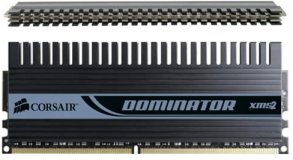
Posted on Monday, March 12 2007 @ 16:52 CET by Thomas De Maesschalck
Corsair presented new memory at CeBIT 2007. The top model is the XMS2 Dominator 2GB kit which is clocked at 1000MHz with 5-5-5-18 timings.
Protect Components While You Push Performance
Pushing performance specs generates heat, and that can compromise reliability and component life. The advanced cooling ability of Dual-path Heat Xchange (DHX) heat sinks keeps your memory safe and reliable even as you push it to the limit. Under the name XMS2 DOMINATOR, this DHX technology will be showing up on both Corsair parts designed for extreme overclocking and on memory designed for performance computing and gaming.
Why Performance DDR2 Memory Must Have Superior Heat Dissipation
Heat is the enemy of your computer's key components. Heat will slow down your system and impact long term reliability. And the more you tweak components for performance, the more heat is generated. With traditional DDR2 memory the standard method of chip packaging involves a BGA (Ball Grid Array). In a BGA, small balls of solder, organized as a grid, are the leads that connect the device to the module circuit board. The innovative first path is through the leads of the BGA chips into the printed circuit board (PCB). When BGA devices are soldered on to a memory module, an all-metal thermal path is created from the surface of the RAM to the copper ground plane of the PCB. This thermal path provides very efficient heat removal. In fact, a study by Micron Semiconductor (application note TN-00-08) indicated that well over half of the heat generated by a memory module is removed in this manner.
Corsair's Unique Dual-path Heat Xchange (DHX) Solves the Problem
Corsair's engineers have developed a unique design that maximizes heat dissipation, even in the most extremely overclocked DDR2 module. The results of recent benchmarks speak for themselves: A DOMINATOR heat sink assembly, using DHX technology and the addition of the Airflow fan, allowed a Corsair module to reach reliable performance at PC8888 or 1111MHz at CAS 4 settings.
